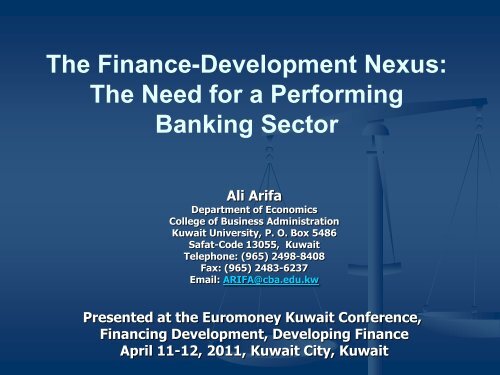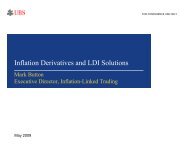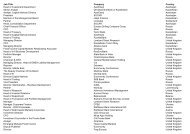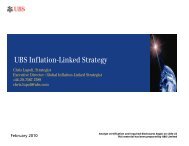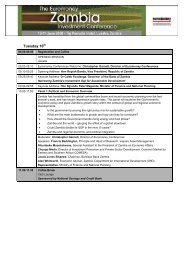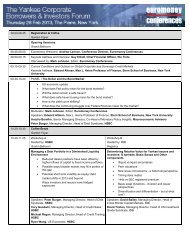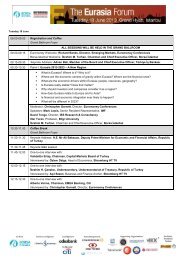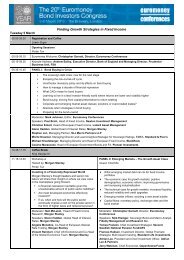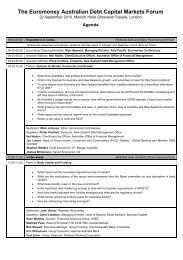KBA Workshop - Euromoney Conferences
KBA Workshop - Euromoney Conferences
KBA Workshop - Euromoney Conferences
Create successful ePaper yourself
Turn your PDF publications into a flip-book with our unique Google optimized e-Paper software.
The Finance-Development Nexus:<br />
The Need for a Performing<br />
Banking Sector<br />
Ali Arifa<br />
Department of Economics<br />
College of Business Administration<br />
Kuwait University, P. O. Box 5486<br />
Safat-Code 13055, Kuwait<br />
Telephone: (965) 2498-8408<br />
Fax: (965) 2483-6237<br />
Email: ARIFA@cba.edu.kw<br />
Presented at the <strong>Euromoney</strong> Kuwait Conference,<br />
Financing Development, Developing Finance<br />
April 11-12, 2011, Kuwait City, Kuwait
What is being Discussed?<br />
Background information on the causal link<br />
between economic growth and development<br />
on one side and financial development on the<br />
other side.<br />
Should the banking sector be a major<br />
contributor in the process of financing growth<br />
(as related to the development plan) in the<br />
state of Kuwait?<br />
Should the State of Kuwait create a<br />
“Development Bank” to assist in financing the<br />
development plan?<br />
The pre-requisites for a successful process of<br />
financing growth in the state of Kuwait.
Financial Development and Economic<br />
Growth, the Direction of Causation:<br />
Theoretical Background<br />
The relationship between financial<br />
development and economic growth has<br />
been the subject of extensive research for<br />
a long time.<br />
This debate has intensified since, the<br />
1980’s with the emergence of the<br />
endogenous growth theory.
The “supply leading” hypothesis:<br />
The argument is that financial deepening<br />
is indeed an engine of economic growth.<br />
In fact, financial deepening is a vital precondition<br />
for tangible growth and<br />
development.<br />
It contends that the development of the<br />
financial system and in particular its<br />
evolution into a market oriented sector<br />
would provide an efficiency stimulus to the<br />
process of capital accumulation in a way<br />
that promotes economic growth.
How does the “supply leading”<br />
hypothesis work?<br />
Both the quantity and quality of<br />
investment are enhanced as a result of<br />
financial development whereby household<br />
real supply of funding increases and<br />
holdings of unproductive tangible<br />
decreases.<br />
Technological innovations as promoted by<br />
financial deepening makes financial<br />
institutions more productive, with a<br />
positive effect on economic growth.
The policy implication the “supply<br />
leading” hypothesis work?<br />
The financial activity is considered as a<br />
major determinant of the real activity<br />
where well functioning financial systems<br />
are crucial for economic growth.<br />
Countries should systematically adopt<br />
appropriate macroeconomic policies,<br />
encourage competition within the financial<br />
sector, and develop a strong and<br />
transparent institutional and legal<br />
framework for financial sector activities.
The “demand following”<br />
hypothesis:<br />
Inspiring economic growth and high levels of<br />
development ultimately create demands for<br />
particular types of improved financial systems.<br />
That is, as the economy becomes more<br />
sophisticated, increased demand for many<br />
services and increasingly adept settings are<br />
inevitable, among which is an increased demand<br />
for financial deepening. The financial system<br />
would eventually respond to this increased<br />
demand.
Policy Implications of the<br />
“demand following” hypothesis:<br />
Financial activity, is the result of economic<br />
growth.<br />
Financial development has very little effect on<br />
economic growth. It simply follows economic<br />
growth as opposed to creating it.<br />
On this ground, any planned efforts to promote<br />
financial development is plainly an unnecessary<br />
use of resources given that a resulting<br />
improvement in the financial sector will have<br />
little effect on growth.
Which direction of causation in<br />
the current context of Kuwait?<br />
Almost irrelevant in light of the current plan and its<br />
vision (“Kuwait 2035”):<br />
"Transforming Kuwait into a financial and trade<br />
center, attractive to investors, where the private<br />
sector leads the economy, creating competition<br />
and promoting production efficiency, under the<br />
umbrella of enabling government institutions,<br />
which accentuates values, safeguards social<br />
identity, and achieves human resource<br />
development as well as balanced development,<br />
providing adequate infrastructure, advanced<br />
legislation and inspiring business environment".
The current status, and the<br />
opportunities for the banking<br />
sector?<br />
The country is implementing a four-year plan (the<br />
biggest in the history of Kuwait), signaling a clear<br />
change in direction for the nation’s economy.<br />
It is a plan with a KD31 billion investment target and<br />
with mega projects.<br />
It is an ambitious plan, specially in relation the role of<br />
the private sector. In line with this, 50 per cent of the<br />
investments required under the plan should come from<br />
the private sector.<br />
Clearly, the banking sector should see an opportunity<br />
with provision of credit lines for the projects of the<br />
plan as long as government support is there.
Commonly cited “worries”:<br />
The nation can not put all of the various<br />
elements of the plan in place.<br />
The private sector could not handle the 50<br />
per cent of the investments required<br />
under the plan.<br />
Funding by commercial banks would not<br />
be sufficient.
So what is being proposed?<br />
Supplement the funding of the plan by a<br />
“state fund”, ie through:<br />
The creation of a state-run national “development bank”<br />
Expanding the role of the Kuwait Fund for Arab<br />
Economic Development to become a provider of credit<br />
(perhaps subsidized credit) to the private sector. (It has<br />
even been proposed to increase the capital of this<br />
institution from KD2 billion to KD 10 billion).
Is “state-run funding” the way to<br />
go?<br />
No, for a number of objective considerations:<br />
1. Strategic consideration:<br />
This represent a clear form of government intervention,<br />
(that gives the public sector even more weight and more<br />
power), which is at odds with the second strategic goal<br />
of the plan:<br />
“The private sector leads the development in<br />
accordance with stimulating mechanisms”
Is “state-run funding” the way to<br />
go?<br />
2. Opportunity cost consideration:<br />
The banking sector will be deprived from a significant<br />
share of the credit market, with a negative effect on the<br />
profitability of this sector. It would lure away investors<br />
and new projects from the Kuwaiti commercial banks.<br />
The banking sector will be subjected to unfair<br />
competition, given that the state fund would not<br />
necessarily be subject to Central Bank regulation. That is<br />
no interference from the Central Bank despite the fact<br />
that banking services are provided (Asymmetry of<br />
regulation).<br />
More importantly, this will result into a missed<br />
opportunity in relation to financial deepening.
Is “state funding” the way to go?<br />
3. Efficiency consideration:<br />
The increase in supply of credit might lead commercial<br />
banks to ease the screening process for loan approval,<br />
(and therefore the violation of safe standards for credit).<br />
The tendency for credit being granted based on “other”<br />
considerations. That is, there is a risk of “soft<br />
conditions” the state-run funding will bring.<br />
Interest rates will be put under pressure causing the<br />
Central Bank of Kuwait to lose one of its most important<br />
monetary policy intervention tools in the saving and<br />
consumer market, which is harmful to the economy as a<br />
whole.
Is the banking sector able to handle<br />
the task?<br />
To start with, there is no evidence to suggest that the<br />
banking sector in the State of Kuwait is not able to<br />
handle the funding for development challenge, in<br />
accordance with the credit policy in place in each bank,<br />
and in accordance with the guidelines of the Central<br />
Bank of Kuwait.<br />
There are 21 domestic and foreign banks are currently<br />
operating in Kuwait, and they do not seem to have<br />
liquidity problem. In fact, judging by 2010 data as<br />
revealed by the Central Bank, the minimum ratio for<br />
liquidity was 18%, and this ratio was at 28.9% at the<br />
end of 2010. This is a strong indicator on the<br />
robustness of the commercial banks position, and<br />
evidence of their capacity to meet the funding<br />
requirements of the development plan.
Is the banking sector able to handle<br />
the task?<br />
Judging by the ratio of loans to deposits in the<br />
Kuwaiti banking sector, there is potential for<br />
additional lending, and for the increase in the<br />
financing capacity of the banks.<br />
Judging by the indicator of capital adequacy<br />
ratios, Kuwait commercial banks are well above<br />
the minimum, even as stipulated by Basel III.<br />
This is an indication of a strong capital base that<br />
allows commercial banks to safely expand their<br />
loan granting activities.
Is the banking sector able to handle<br />
the task?<br />
The funding capacity by commercial banks<br />
is expected to increase in light of the<br />
expected improvement in economic<br />
conditions domestically and externally,<br />
and the associated increase in their ability<br />
to attract deposits, and strengthen their<br />
capital bases.


